1998 VOLVO V90 roof
[x] Cancel search: roofPage 57 of 175

1998 Volvo S90
l To slide open the sun roof :
press the lower section of the
switch.
l To close the sun roof :press
the upper section of the
switch until the sun roof has
closed completely .
l To open the rear edge of
the sun roof (ventilation
position): press the upper
section of the switch. Press
the lower section of the
switch to return the sun roof
to the closed position.
with the sun roof when the sun roof slides
back (not when the sun roof is opened to
the ventilation position).
l The sun shade can also be opened
manually even if the sun roof is closed.
l The sun shade will not close
automatically with the sun roof. It must be
closed manually.
WARNING! (SUN ROOF): The sun
roof must never be obstructed in any
way when in operation.
an overload protecting circuit breaker
(fuse no. 26) which is activated when an
object blocks the sun roof. Should this
occur, remove the object and wait 20
seconds for the circuit breaker to reset.
The sun roof should then function
normally.
l To help alleviate "rumbling" wind
noise when the sun roof is open, adjust the
position slightly (open/close).
Long load storage (sedan) pg. 50
Long load storage
In the panel behind the rear seat is a door
which makes it possible to carry long
loads such as skis, etc.
WARNING!
Cover sharp edges on load to help
prevent injury to occupants. Secure
load to help prevent shifting during
sudden stops.
Protective covers (for skis) should
also be used to avoid soiling or
tearing the upholstery. Please note
that the flap in the rear seat is only
intended for light loads such as skis,
carpets, etc.
Max. length of load 6 1/2 ft = 2m.
Max. weight of load 33 lbs = 15 kg.
file:///K|/ownersdocs/1998/1998_SV90/98S90_048.htm (2 of 4)12/30/2006 \
1:52:40 PM
Page 63 of 175

1998 Volvo S90
Volvo allows the use of the
following "oxygenated fuels";
however, the octane ratings
listed on this page must still be
met. of fuel. Therefore, it is
advisable to refuel as soon as
possible when the needle nears
the red zone, or when the fuel
warning light comes on.
Driving economy pg. 56
Economical driving
conserves natural
resources
Better driving economy may be
obtained by thinking ahead,
avoiding rapid starts and stops
and adjusting the speed of your
vehicle to immediate traffic
conditions. Observe the
following rules:
l Bring the engine to normal
operating temperature as soon
as possible by driving with a
light foot on the accelerator
pedal for the first few minutes
of operation. A cold engine
uses more fuel and is subject to
increased wear.
l Whenever possible, avoid
using the car for driving short
distances. This does not allow
the engine to reach normal
operating temperature.
l Drive carefully and avoid
rapid acceleration and hard
braking.
l Do not exceed speed limit.
l Avoid carrying unnecessary
items (extra load) in the car.
l Check tire pressure regularly
l Remove snow tires when
threat of snow or ice has ended.
l Note that roof racks, ski
racks, etc., increase air
resistance and thereby fuel
consumption.
l Avoid using automatic
transmission kick-down feature
unless necessary.
l Avoid using the air
conditioning when it is not
required. When engaged, the
air conditioner's compressor
places places an additional load
on the engine. However, please
note that fuel consumption is
lower with the air conditioning
on than it is when driving with
the air conditioning switched
off and the windows down.
Other factors which decrease
gas mileage are:
l Worn or dirty spark plugs
l Incorrect spark plug gap
l Dirty air cleaner
l Dirty engine oil and clogged
oil filter
l Dragging brakes
l Incorrect front end alignment
Some of the above mentioned
file:///K|/ownersdocs/1998/1998_SV90/98S90_053.htm (4 of 6)12/30/2006 \
1:52:41 PM
Page 71 of 175

1998 Volvo S90
disconnected, the code must
be re-entered before the radio
will function properly.
Points to remember pg. 62
Weight distribution affects
handling
At the specified curb weight
your car has a tendency to
understeer, which means that the
steering wheel has to be turned
more than might seem
appropriate for the curvature of
a bend. This ensures good
stability and reduces the risk of
rear wheel skid. Remember that
these properties can alter with
the vehicle load. The heavier the
load in the trunk, the less the
tendency to understeer.
Handling, roadholding
Vehicle load, tire design, and
inflation pressure, all affect
vehicle handling. Therefore,
check that the tires are inflated
to the recommended pressure
according to the vehicle load.
See "Tire pressure" section.
Loads should be distributed so
that capacity weight or
maximum permissible axle loads
are not exceeded.
WARNING!
An extra mat on the driver's
floor can cause the
accelerator pedal to catch.
Check that the movement of
the accelerator pedal is not
impeded. Not more than one
protective floor covering may
be used at one time.
CAUTION: Drive slowly and
carefully if going through
standing water (i.e. flooded
roadways, etc.). Damage to
engine could result if excess
water is ingested through the air
intake system. Never drive the
vehicle in water deeper than 1
foot (300 mm). See the flood
warning on page 7.
WARNING! Do not drive
with trunk lid or tailgate
open!
Poisonous exhaust gases may
enter via the trunk lid or
tailgate.
If the trunk lid/tailgate must
be kept open for any reason,
proceed as follows:
l Close the windows.
l Set the ventilation system
Roof rails/racks
Roof rails are standard
equipment on wagon models.
Load bars are available as a
retailer installed option on the
sedan models. Observe the
following points when is use:
l Avoid single-point loads.
Distribute the load evenly.
l Place heavier cargo at bottom
of load.
l Observe that center of gravity
and handling are influenced by
load weight.
l Increasing load size increases
wind resistance and, thus,
adversely affects fuel economy.
l Anchor the cargo correctly
with appropriate tie-down
equipment.
l Drive carefully. Avoid rapid
starts, fast cornering and hard
braking.
l Max. roof load is 220 lbs.
(100 kg) for removable racks.
For permanent roof racks, check
the manufacturers weight
specifications.
file:///K|/ownersdocs/1998/1998_SV90/98S90_058.htm (6 of 7)12/30/2006 \
1:52:42 PM
Page 102 of 175
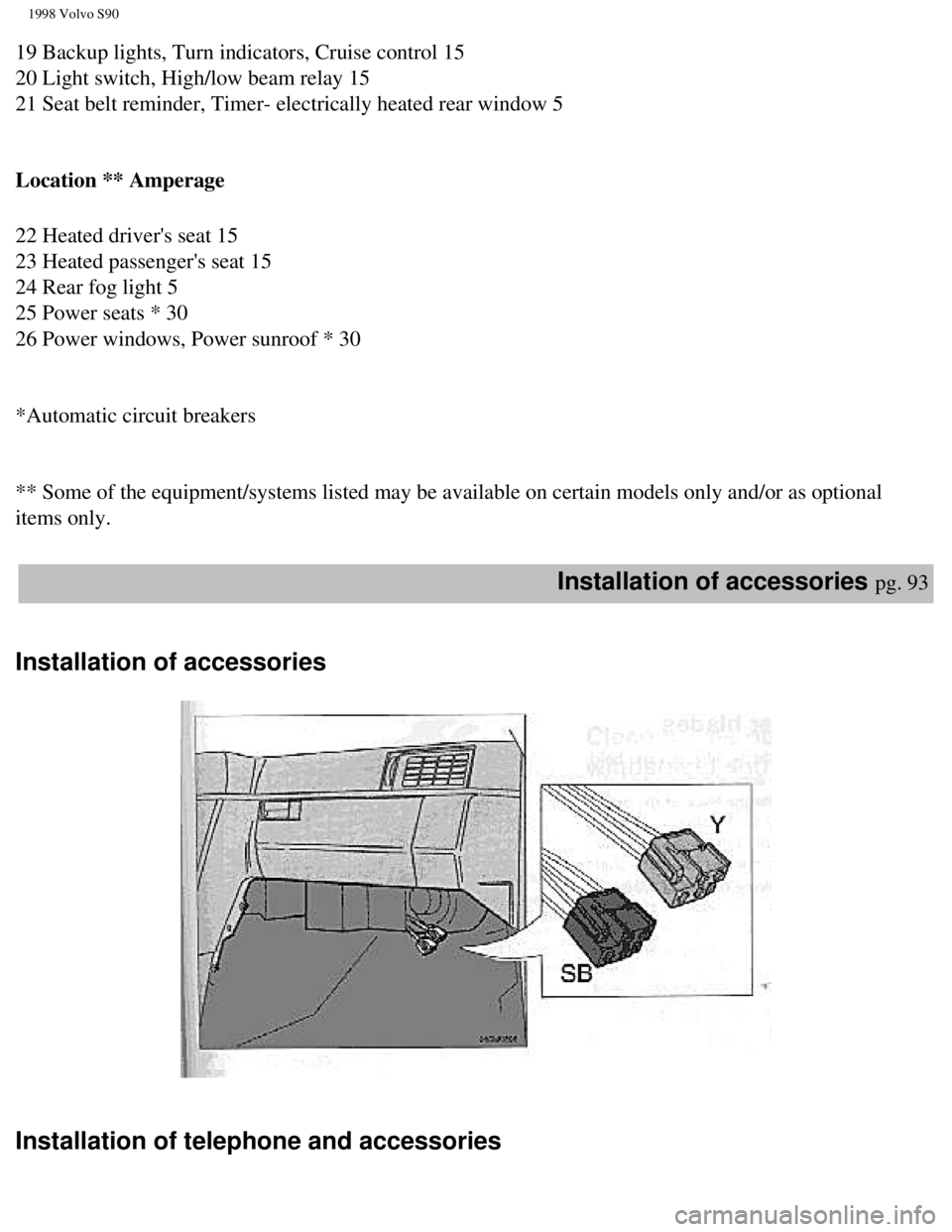
1998 Volvo S90
19 Backup lights, Turn indicators, Cruise control 15
20 Light switch, High/low beam relay 15
21 Seat belt reminder, Timer- electrically heated rear window 5
Location ** Amperage
22 Heated driver's seat 15
23 Heated passenger's seat 15
24 Rear fog light 5
25 Power seats * 30
26 Power windows, Power sunroof * 30
*Automatic circuit breakers
** Some of the equipment/systems listed may be available on certain mode\
ls only and/or as optional
items only.
Installation of accessories pg. 93
Installation of accessories
Installation of telephone and accessories
file:///K|/ownersdocs/1998/1998_SV90/98S90_089.htm (6 of 9)12/30/2006 \
1:52:46 PM
Page 103 of 175
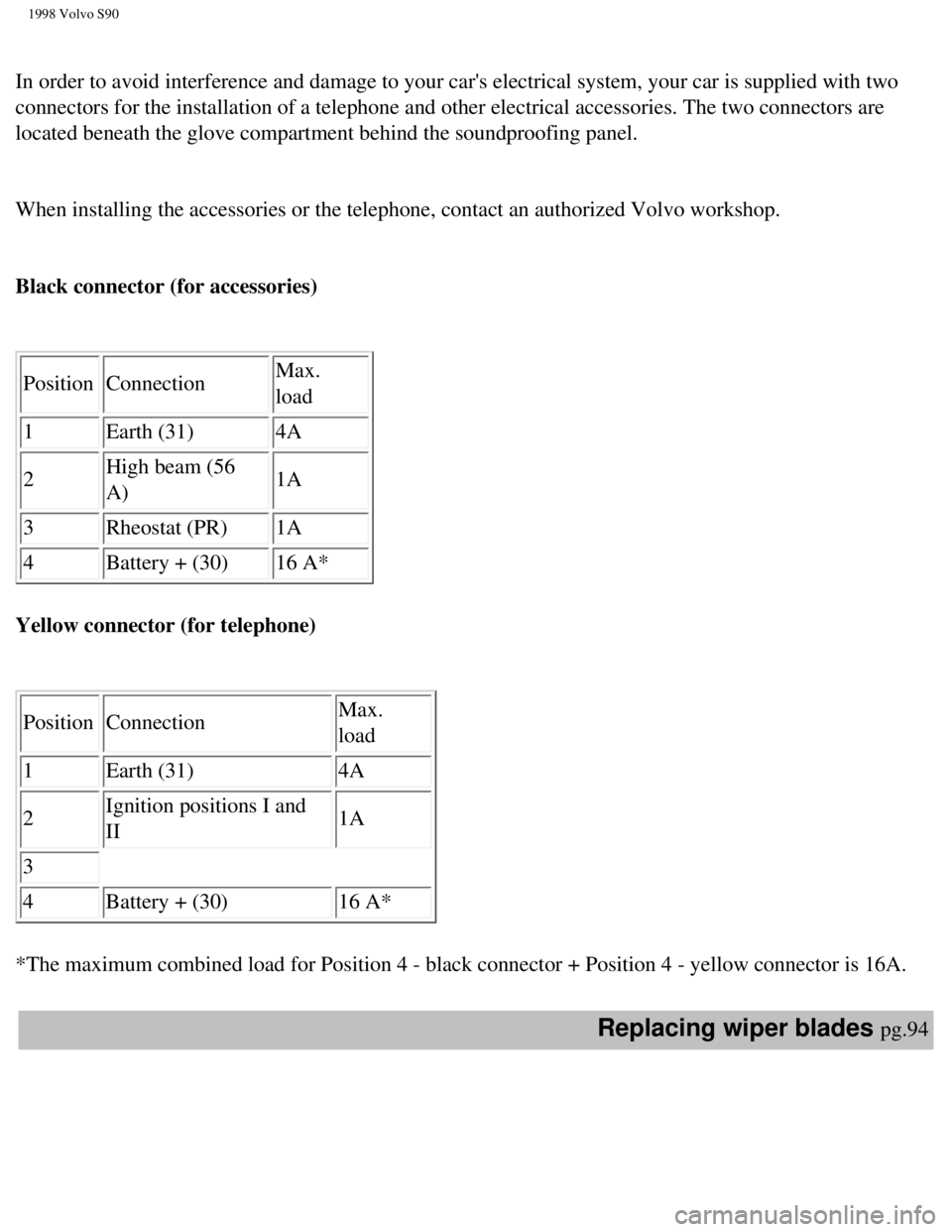
1998 Volvo S90
In order to avoid interference and damage to your car's electrical syste\
m, your car is supplied with two
connectors for the installation of a telephone and other electrical acce\
ssories. The two connectors are
located beneath the glove compartment behind the soundproofing panel.
When installing the accessories or the telephone, contact an authorized \
Volvo workshop.
Black connector (for accessories)
Position Connection Max.
load
1 Earth (31) 4A
2 High beam (56
A) 1A
3 Rheostat (PR) 1A
4 Battery + (30) 16 A*
Yellow connector (for telephone)
Position Connection Max.
load
1 Earth (31) 4A
2 Ignition positions I and
II 1A
3
4 Battery + (30) 16 A*
*The maximum combined load for Position 4 - black connector + Position 4\
- yellow connector is 16A.
Replacing wiper blades pg.94
file:///K|/ownersdocs/1998/1998_SV90/98S90_089.htm (7 of 9)12/30/2006 \
1:52:46 PM
Page 117 of 175
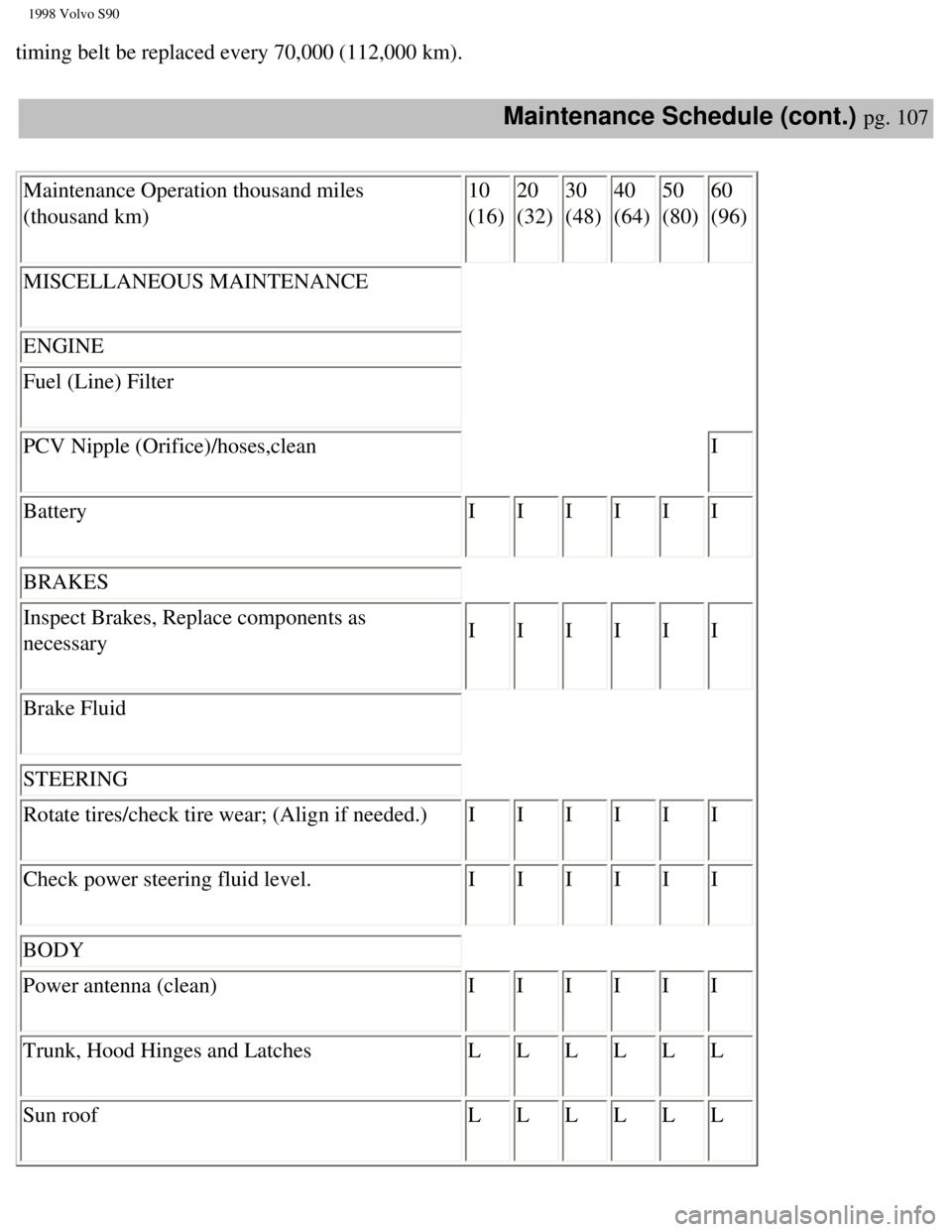
1998 Volvo S90
timing belt be replaced every 70,000 (112,000 km).
Maintenance Schedule (cont.) pg. 107
Maintenance Operation thousand miles
(thousand km) 10
(16) 20
(32) 30
(48) 40
(64) 50
(80) 60
(96)
MISCELLANEOUS MAINTENANCE
ENGINE
Fuel (Line) Filter
PCV Nipple (Orifice)/hoses,clean I
Battery I I I I I I
BRAKES
Inspect Brakes, Replace components as
necessary I
I I I I I
Brake Fluid
STEERING
Rotate tires/check tire wear; (Align if needed.) I I I I I I
Check power steering fluid level. I I I I I I
BODY
Power antenna (clean) I I I I I I
Trunk, Hood Hinges and Latches L L L L L L
Sun roof L L L L L L
file:///K|/ownersdocs/1998/1998_SV90/98S90_103.htm (6 of 7)12/30/2006 \
1:52:48 PM
Page 126 of 175
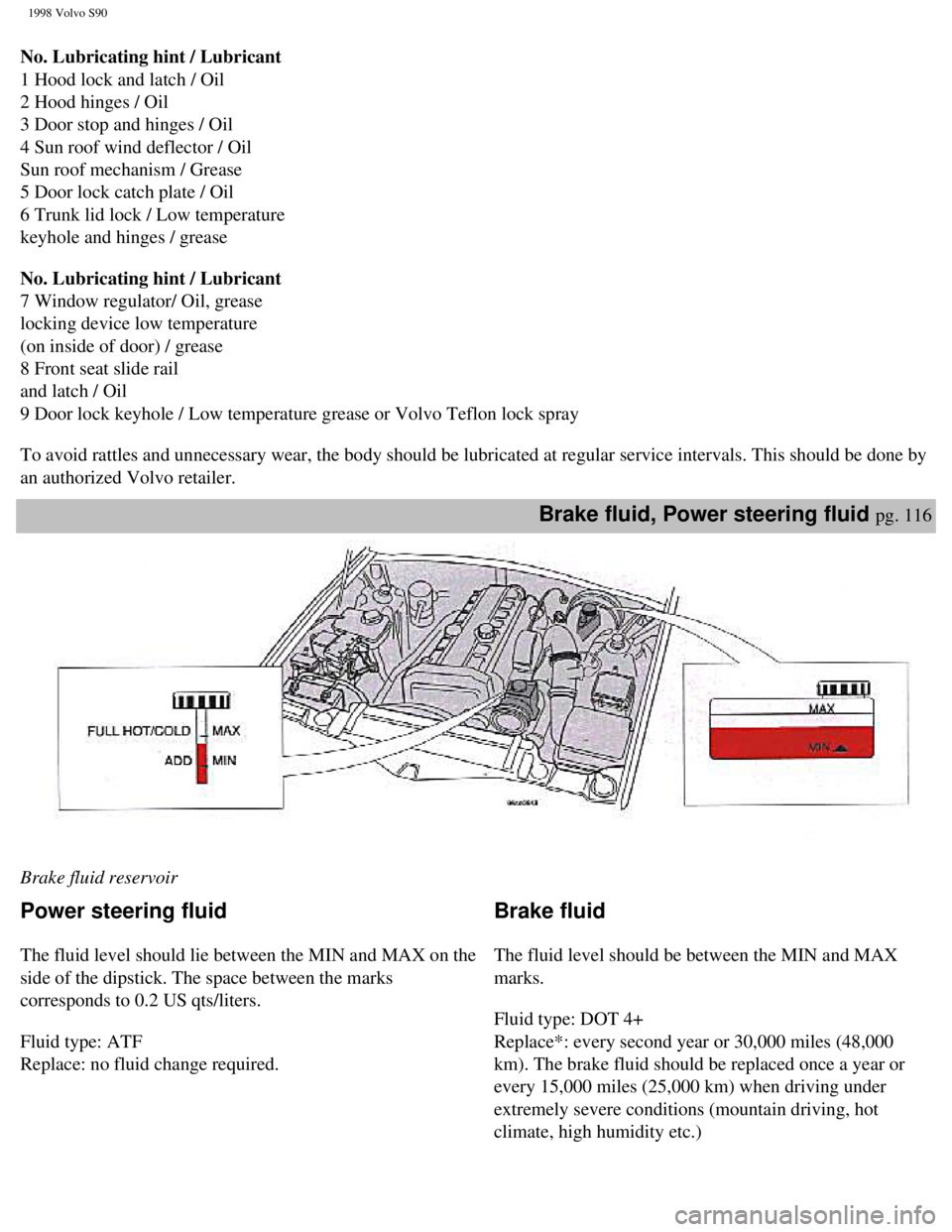
1998 Volvo S90
No. Lubricating hint / Lubricant
1 Hood lock and latch / Oil
2 Hood hinges / Oil
3 Door stop and hinges / Oil
4 Sun roof wind deflector / Oil
Sun roof mechanism / Grease
5 Door lock catch plate / Oil
6 Trunk lid lock / Low temperature
keyhole and hinges / grease
No. Lubricating hint / Lubricant
7 Window regulator/ Oil, grease
locking device low temperature
(on inside of door) / grease
8 Front seat slide rail
and latch / Oil
9 Door lock keyhole / Low temperature grease or Volvo Teflon lock spray \
To avoid rattles and unnecessary wear, the body should be lubricated at \
regular service intervals. This should be done by
an authorized Volvo retailer.
Brake fluid, Power steering fluid pg. 116
Brake fluid reservoir
Power steering fluid
The fluid level should lie between the MIN and MAX on the
side of the dipstick. The space between the marks
corresponds to 0.2 US qts/liters.
Fluid type: ATF
Replace: no fluid change required.Brake fluid
The fluid level should be between the MIN and MAX
marks.
Fluid type: DOT 4+
Replace*: every second year or 30,000 miles (48,000
km). The brake fluid should be replaced once a year or
every 15,000 miles (25,000 km) when driving under
extremely severe conditions (mountain driving, hot
climate, high humidity etc.)
file:///K|/ownersdocs/1998/1998_SV90/98S90_114.htm (2 of 5)12/30/2006 \
1:52:50 PM
Page 139 of 175
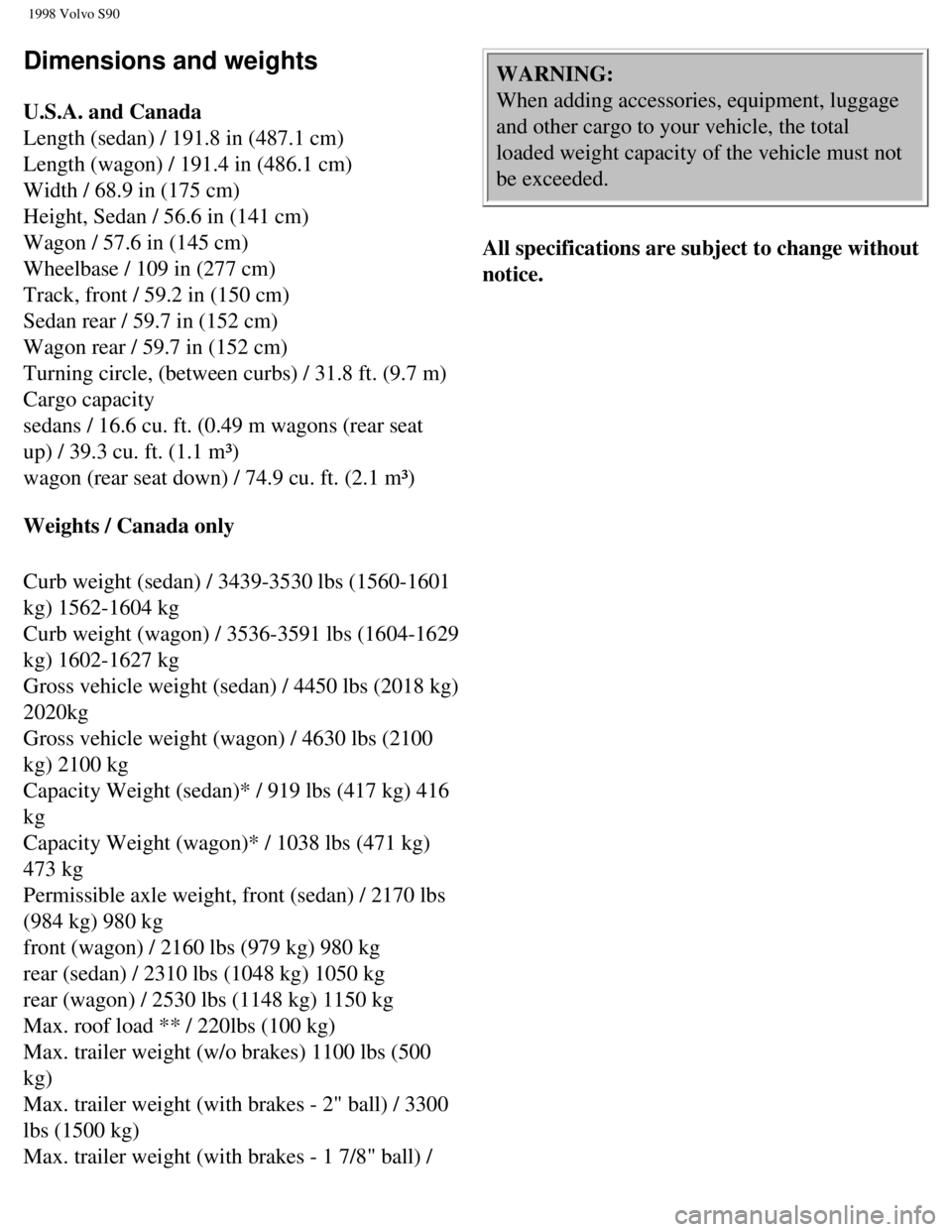
1998 Volvo S90
Dimensions and weights
U.S.A. and Canada
Length (sedan) / 191.8 in (487.1 cm)
Length (wagon) / 191.4 in (486.1 cm)
Width / 68.9 in (175 cm)
Height, Sedan / 56.6 in (141 cm)
Wagon / 57.6 in (145 cm)
Wheelbase / 109 in (277 cm)
Track, front / 59.2 in (150 cm)
Sedan rear / 59.7 in (152 cm)
Wagon rear / 59.7 in (152 cm)
Turning circle, (between curbs) / 31.8 ft. (9.7 m)
Cargo capacity
sedans / 16.6 cu. ft. (0.49 m wagons (rear seat
up) / 39.3 cu. ft. (1.1 m³)
wagon (rear seat down) / 74.9 cu. ft. (2.1 m³)
Weights / Canada only
Curb weight (sedan) / 3439-3530 lbs (1560-1601
kg) 1562-1604 kg
Curb weight (wagon) / 3536-3591 lbs (1604-1629
kg) 1602-1627 kg
Gross vehicle weight (sedan) / 4450 lbs (2018 kg)
2020kg
Gross vehicle weight (wagon) / 4630 lbs (2100
kg) 2100 kg
Capacity Weight (sedan)* / 919 lbs (417 kg) 416
kg
Capacity Weight (wagon)* / 1038 lbs (471 kg)
473 kg
Permissible axle weight, front (sedan) / 2170 lbs
(984 kg) 980 kg
front (wagon) / 2160 lbs (979 kg) 980 kg
rear (sedan) / 2310 lbs (1048 kg) 1050 kg
rear (wagon) / 2530 lbs (1148 kg) 1150 kg
Max. roof load ** / 220lbs (100 kg)
Max. trailer weight (w/o brakes) 1100 lbs (500
kg)
Max. trailer weight (with brakes - 2" ball) / 3300
lbs (1500 kg)
Max. trailer weight (with brakes - 1 7/8" ball) / WARNING:
When adding accessories, equipment, luggage
and other cargo to your vehicle, the total
loaded weight capacity of the vehicle must not
be exceeded.
All specifications are subject to change without
notice.
file:///K|/ownersdocs/1998/1998_SV90/98S90_125.htm (6 of 7)12/30/2006 \
1:52:51 PM